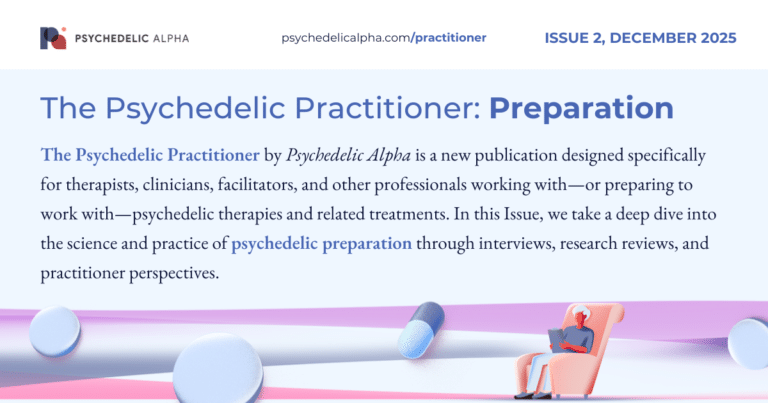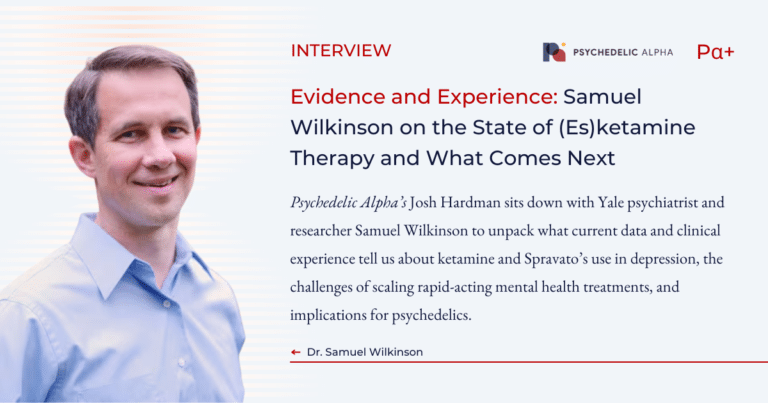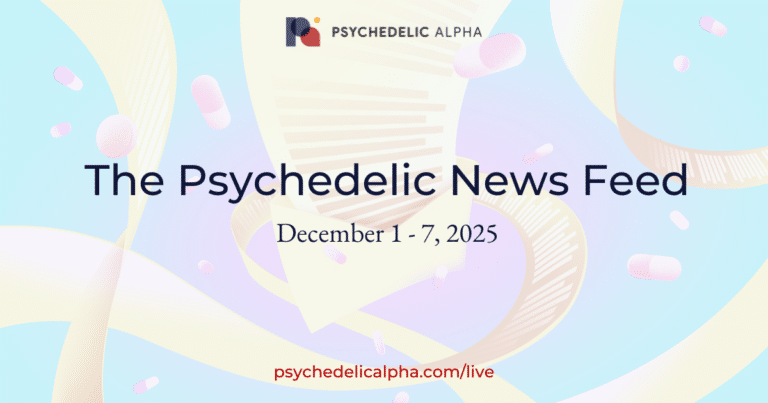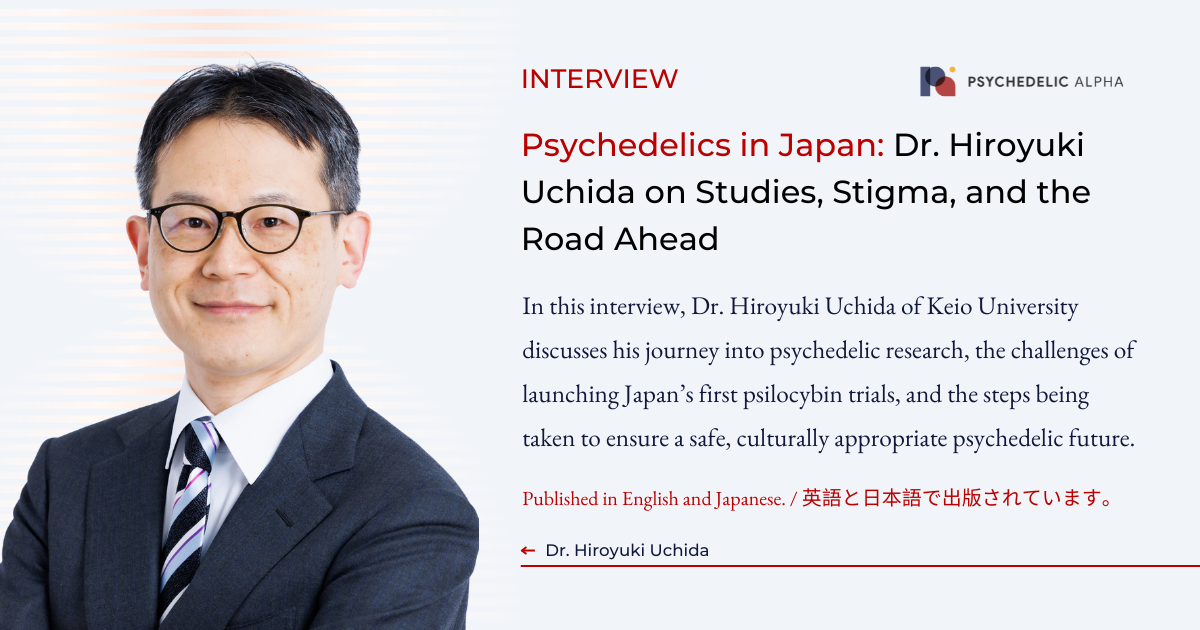Editor’s Note: The following interview is published in both English and Japanese. To read the Japanese version, please scroll down (or click here).
このインタビューは英語と日本語で公開されています。日本語を読みたい方は、スクロール(もしくはここをクリック)してください。 ∎
As global interest in the clinical use of psychedelic-based treatments continues to expand, Japan is beginning to carve its own path, marked by cultural attunement, regulatory compliance, and scientific rigour. At the forefront of this push is Dr. Hiroyuki Uchida, Chair and Professor at the Department of Neuropsychiatry, Keio University School of Medicine in Tokyo, Japan. Aside from his slate of clinical trials, brain imaging work, and preclinical studies, Dr. Uchida also finds time for Judo, in which he holds a black belt.
In this interview, Dr. Uchida discusses how his early fascination with the Maya civilisation led him from a childhood interest in archaeology into psychiatry, why psilocybin became a natural focus of his research, and the challenges of pioneering Japan’s first clinical studies of psychedelic therapy in the 21st century. He also shares insights into adapting psychedelic research and roll-out frameworks for the Japanese context and reflects on a new industry–academia partnership with Otsuka aimed at paving the way for “safe and culturally appropriate introduction of psychedelic therapies in Japan.”
I had learned about the use of magic mushrooms in ancient Maya rituals when I was young, so I began this work with genuine curiosity and no prejudice.
Josh Hardman, Psychedelic Alpha: How did you first become interested in psychedelic research, and psilocybin in particular?
Dr. Hiroyuki Uchida: From early adolescence, I was fascinated by the Maya civilisation and even aspired to become an archaeologist. In high school, I encountered a psychiatrist’s book investigating the Maya from a psychiatric perspective. That experience reshaped my interests. I realised I wanted to explore human culture and consciousness through the lens of psychiatry, which led me to study medicine. Eventually, I specialised in brain imaging and psychopharmacology, focusing on therapeutic mechanisms in psychiatry.
Now, as I work on psychedelic research, I feel a profound sense of returning to my original passion, but through a medical and scientific lens. I had learned about the use of magic mushrooms in ancient Maya rituals when I was young, so I began this work with genuine curiosity and no prejudice. Psilocybin, in particular, felt like a natural focus—not only because of its cultural significance but also due to its growing body of clinical evidence and favourable safety profile when used in therapeutic settings.
Hardman: Can you share a brief overview of your research to date, including key findings?
Uchida: We are conducting the first clinical trial in Asia (in the 21st century) to investigate the safety, feasibility, and preliminary efficacy of psilocybin therapy for treatment-resistant depression. While the study is still ongoing, our initial observations align with findings from the U.S. and Europe—namely, that psilocybin administered in a safe, structured therapeutic environment may significantly reduce depressive symptoms in some individuals.
Another important aspect of our work involves cultural and linguistic adaptations of research tools. For example, we translated and validated the Mystical Experience Questionnaire (MEQ) and other psychometric scales for Japanese participants to ensure that subjective experiences are accurately measured in our cultural context.
Hardman: What was the process of getting funding from AMED like? Did you experience any stigma from the agency, or your colleagues at Keio?
Uchida: Securing research funding from the Japan Agency for Medical Research and Development (AMED) involved a rigorous application and review process. Given the controlled status of psilocybin, we were required to demonstrate strong safety protocols, ethical oversight, and a compelling scientific rationale.
While there was some initial hesitation—mainly due to unfamiliarity with psychedelic research—most responses were cautious rather than outright dismissive. Both AMED and IRB were understandably conservative, but their concerns centred on proper governance and patient safety.
Hardman: What do you believe are the biggest challenges to researching and rolling out psychedelic therapies in Japan?
Uchida: Several major challenges remain:
- Regulatory barriers: Japan enforces strict laws on controlled substances, so importing, storing, and using psychedelics requires navigating complex legal and administrative procedures.
- Social stigma: The term “hallucinogens” still carries negative connotations in Japan. Public education and clear communication about “psychedelics” will be essential.
- Lack of infrastructure and experience: Few clinical teams in Japan are trained in psychedelic-assisted therapy. We need to develop training programs and build multidisciplinary teams.
- Funding and institutional support: Long-term funding remains limited, and institutional frameworks for supporting this type of research are still under development.
Hardman: Do you think Japanese regulators (e.g., PMDA) will expect to see Japanese clinical trials before approving a psychedelic-based treatment for launch in the country?
Uchida: Yes, I believe so. The Pharmaceuticals and Medical Devices Agency (PMDA) generally requires clinical data from Japanese participants or locally conducted trials before granting approval. This is consistent with their cautious and population-specific approach to new treatments.
The “set and setting” model needs to be adapted to reflect Japanese cultural norms, emotional expression styles, and therapeutic expectations.
Hardman: What other elements of psychedelic research and roll-out might need to be tailored to fit the Japanese context?
Uchida: Several:
- Language and instruments: It is not enough to simply translate assessment tools—we must ensure that they are culturally meaningful and conceptually accurate.
- Therapeutic setting and protocol: The “set and setting” model needs to be adapted to reflect Japanese cultural norms, emotional expression styles, and therapeutic expectations.
- Public and professional engagement: We need to proactively address public misconceptions and provide balanced information to healthcare professionals, policymakers, and the media.
- Training and capacity-building: Therapists, psychiatrists, nurses, and support staff will require specialised training in psychedelic-assisted therapy to ensure safe and effective delivery.
Additionally, on May 8, 2025, Keio University entered into a joint research agreement with Otsuka Pharmaceutical to collaboratively establish the foundation for the responsible implementation of psychedelic therapies in Japan. This industry–academia partnership aims to address critical areas including optimal clinical trial design, professional training systems, legal and ethical frameworks, and reduction of social stigma. We believe this collaboration represents a significant step toward the safe and culturally appropriate introduction of psychedelic therapies in Japan. ∎
Japanese Version
現在精神展開剤の研究に取り組んでいることに、医療・科学という新たな視点を通じて、かつての情熱に立ち返るような深い感慨を感じています。
Josh Hardman, Psychedelic Alpha: 精神展開剤研究、とくにシロシビンに興味を持ったきっかけは何ですか?
Dr. Hiroyuki Uchida: 思春期の頃からマヤ文明に強く惹かれており、当時は考古学者を目指していました。高校時代に、精神科医が精神医学的観点からマヤ文明を考察した本に出会い、その経験が私の関心を大きく変えました。人間の文化や意識を精神医学という視点から探求したいと思うようになり、医学を志しました。最終的には脳画像研究と精神薬理学を専門とし、精神科領域における治療メカニズムの研究に携わるようになりました。
現在精神展開剤の研究に取り組んでいることに、医療・科学という新たな視点を通じて、かつての情熱に立ち返るような深い感慨を感じています。若い頃、古代マヤの儀式でマジックマッシュルームが使われていたことを知っていたため、この分野には純粋な好奇心と偏見のない姿勢で取り組めています。特にシロシビンは、その文化的背景のみならず、近年蓄積されてきた臨床エビデンスや治療環境下での安全性の高さから、自然と研究の中心になりました。
Hardman:これまでの研究の概要と主な成果を教えてください。
Uchida: 現在、治療抵抗性うつ病に対するシロシビン療法の安全性、実行可能性、有効性を検証するため、アジアで(21世紀に入ってから)初となる臨床試験を実施しています。研究は実施中ですが、現時点での結果は、米国や欧州の研究と一致しており、安全で構造化された治療環境下で投与されたシロシビンが、一部の患者の抑うつ症状を有意に軽減する可能性を示しています。
また、私たちの研究では、調査ツールの文化的・言語的適応も重要な要素です。たとえば、「神秘体験質問票(MEQ)」などの心理測定尺度を日本語に翻訳・検証し、日本人参加者の主観的体験を正確に評価できるよう工夫しています。
Hardman: AMED(日本医療研究開発機構)からの研究資金獲得の過程はいかがでしたか?また、AMEDや慶應義塾大学内での偏見はありましたか?
Uchida: AMEDからの研究資金の獲得には、厳格な申請・審査プロセスがあります。シロシビンは規制物質であるため、安全管理体制、倫理的監督体制、そして科学的妥当性をしっかりと示す必要がありました。
当初は精神展開剤研究に対する認知が乏しく、一部にためらいも見られましたが、あからさまな拒否というよりも、慎重な姿勢が多かった印象です。AMEDや倫理審査委員会も保守的ではありましたが、それは適切なガバナンスや患者の安全を重視してのものでした。
Hardman: 日本で精神展開剤による治療を研究・導入する上での最大の課題は何だと思いますか?
Uchida: 主に以下の点が課題として挙げられます:
- 法規制の壁:日本でも規制薬物に関する法律が非常に厳しく、精神展開剤の輸入・保管・使用には煩雑な手続きが必要です。
- 社会的スティグマ:「幻覚剤」という言葉には依然としてネガティブな印象がついてまわります。「精神展開剤」という概念を明確に伝え、正しい知識の普及が不可欠です。
- インフラと経験の不足:日本では精神展開剤による治療に関する臨床チームの育成が進んでいません。多職種チームとトレーニング体制の構築が求められます。
- 資金と制度的支援:長期的な研究資金や制度的支援が依然として限られており、持続可能な研究体制の確立が課題です。
Hardman: 日本の規制当局(たとえばPMDA)は、精神展開剤の国内承認のために日本国内の臨床試験を求めると思いますか?
Uchida: はい、そう考えています。PMDA(医薬品医療機器総合機構)は、通常、日本人を対象とした臨床データや国内で実施された試験を重視します。これは、新しい治療法に対する慎重かつ対象集団に特化したアプローチと一致しています。
治療環境とプロトコル:「セットとセッティング」の概念を、日本の文化的価値観や感情表現、治療への期待に即して調整する必要があります。
Hardman: 日本の文脈に合わせて調整が必要と思われる要素にはどのようなものがありますか?
Uchida:
- 言語と評価尺度:単に翻訳するだけでなく、文化的な意味や概念的な正確性を確保する必要があります。
- 治療環境とプロトコル:「セットとセッティング」の概念を、日本の文化的価値観や感情表現、治療への期待に即して調整する必要があります。
- 社会的・専門的啓発:誤解や偏見を解き、医療従事者・政策立案者・メディアに対しバランスの取れた情報提供が必要です。
- トレーニングと人材育成:心理士、精神科医、看護師、支援スタッフが安全かつ効果的に治療を提供するための専門的トレーニングが求められます。
加えて、2025年5月8日には、慶應義塾大学と大塚製薬株式会社との間で共同研究契約が締結され、日本における精神展開剤療法の社会実装を目指した産学連携体制がスタートしました。この連携では、最適な臨床試験デザイン、専門家育成制度、法的・倫理的枠組み、社会的スティグマの軽減といった重要課題に取り組む予定です。日本における精神展開剤療法の安全かつ文化的に適切な導入に向けた重要な一歩と考えています。
You might also like…

The Psychedelic Practitioner Issue 2: Preparation


The Psychedelic News Feed: December 1 – 7, 2025


